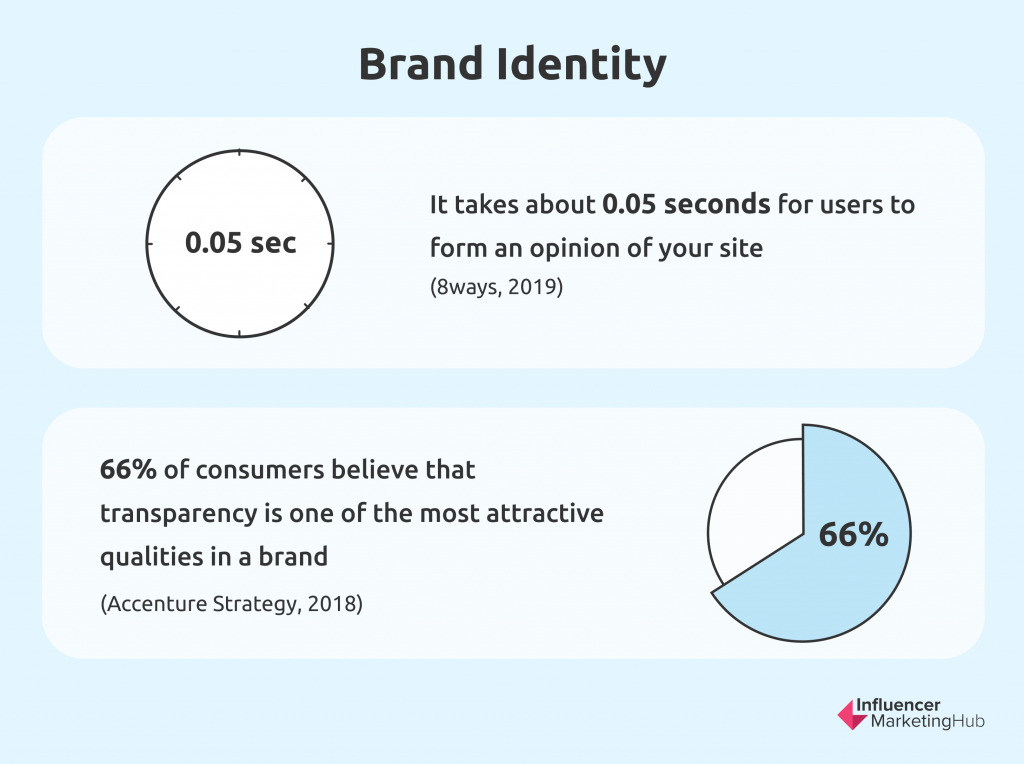Brand identity is one of the latest buzz phrases. While brand identity is far from a new concept (Coca-Cola has boasted a strong one for decades), it is still misunderstood and underutilized by many businesses.
Your brand identity is much more than simply a logo. The logo of the business is merely one of the several digital assets that you can use to create your brand identity. Additionally, it's important to recognize the power of consistent brand presentation, which, as highlighted in our branding statistics, can increase revenue by up to 23%. Thus, to create a unique brand identity, you need to pay attention to various other elements in addition to your logo.
So, whether you are a solopreneur or a global conglomerate, your first step should be to create a unique brand identity. Here are simple steps to help you develop a strong brand identity for 2024.
How to Develop a Unique Brand Identity in 2024:
What Is a Brand Identity?
In short, your brand identity is the sum of the values of your business, how you portray your products or services and, ultimately, what your target audience experiences whenever they are directly involved with your brand. It refers to elements that help people to recognize your business immediately.
While the term “brand identity” is sometimes used interchangeably with “branding”, these are, in fact, different concepts. Simply put, “branding” refers to the process of actively creating the perception of your business among consumers.
The Importance of a Brand Identity

Millions of businesses are searching for innovative ways to set themselves apart from their competitors. To do so effectively, you will need an easy recognizable and memorable brand.
Though, your brand identity is so much more than simply making sure you get noticed. It is a personification of who your business is and their offerings. Thus, a strong brand identity can help you to become more likeable among your audience (sadly, the reverse is equally true).
Not only will it make you more popular, but it will help you to stand out as a reliable leader in your industry. By continuously working on your identity, your audience as well as your competitors will view you as trustworthy and credible.
This is immensely valuable, considering the current branding stats. A study completed by Edelman has found that more than 80% of consumers need to be able to trust the brand before they can buy from them. What is more, these first-time buyers are more inclined to become returning customers or even brand advocates when a business takes the time to develop their brand identity.
Not only will it rub off on your customers, but also on your company and employees. Your brand identity helps to give your business a goal and mission. It also helps to make your digital marketing strategy easier as a well-crafted brand identity serves as a sort of blueprint of all the elements that you need to include. Whether it is a video on YouTube or an online ad, it becomes much easier to create advertisements that will impress.
How to Create a Brand Identity
1. Research

Like most things in life, research will be a key step in the process. When creating a unique brand identity, you need to research your target audience, and competition, but also do some introspection and consider the mission, personality, voice and values of your business.
Good advertising adjusts how it markets a product or service to different target audiences. To help you with this step, you need to find out more about what your target audience is searching for in your type of business. You might think that it is good for business to reach everyone, but, while tempting, this should never be your goal.
Researching your competition is not only good for business, but also for creating a unique brand identity (with the emphasis on unique). As the goal of branding is to help you set yourself apart, focus on the differences between you and your competitors. This exercise will also help you to avoid branding strategies that did not produce results for your competitors.
Knowing which products and/or services your business offers is not enough. You also need to have a mission statement that spells out the goal, values and vision of your business. Businesses with strong brand identities know precisely who they and their target audience are.
To help you during the research process, you might want to do a SWOT Analysis. In other words, take the time to identify your strengths, weaknesses, opportunities and threats. This process might feel time-consuming and challenging, but without this step everything else will fall apart.
2. Create your digital design assets
Your digital design assets refer to the concrete building blocks that will help to shape how others perceive your brand. These include the following:
Logo
The logo is a key digital asset that you will use to create a brand identity. It will feature everywhere from your website to your newsletters. As it will be used so widely, it will be one of the most identifiable parts of your brand.
Thus, while it should be visually pleasing, it should also be meaningful and tell consumers more about your business. Even if you are trying to create a modern look and feel, it is better to go for a more classic logo. As you should not change your logo often, your logo design should steer away from the latest trends and, instead, strive to be timeless.
Packaging
How you present your services or physically package your products is another important element to branding. By ensuring that even seemingly trivial details like your packaging tie in with your brand identity, you will create consistency which ultimately helps people to become more familiar with your business.
Signage
Brands that have brick-and-mortar storefronts will also have to pay attention to their signage. The signage that you use forms a significant part of the customer experience. From your little sale sign in your window display to the signage for a new pop-up shop, all your signage should be compelling, yet consistent with your other design assets.
Color palettes
According to research completed by Diane E. Moir, brand colors can boost recognition by more than 80%. What is more, the same study has also found that consumers make a subconscious judgment about a product within only 90 seconds and as much as 90% of that judgment is solely based on color.
By taking the time to curate a color palette, you can create unique designs which will at the same time stay true to your brand identity.
Typography
Typography refers to the fonts that you will be using and it can reveal loads about your business. For example, classic typography (like serif fonts) communicates that your business is more traditional, while sans serif fonts (such as Helvetica), on the other hand, help to create a more modern look and feel.
From your logo right through to all the print as well as digital documents that you create, you should use your typography consistently. In other words, you should try to use the same type of style across your different platforms and, ideally, limit it to no more than three readable font families.
Templates
As mentioned numerous times before already, consistency is absolutely key. It can be the factor that decides whether your brand identity will be a success or a failure.
So, to help you create a unified look, consider creating a few templates. For example, by creating a template for emails, you can ensure that your emails are easy to read, yet informative. It will also help your business to come across as professional at all times.
Brand style guide
While templates can help you to create a harmonious look and feel, they are no replacement for a brand style guide. In short, this is a document that lists rules and guidelines for using all your design assets. It is the easiest way to make sure that all your design work that you create in the future aligns with your brand identity to create the correct perception.
3. Integrate your brand
Armed with insight into your business (and its competitors) and a set of strong digital assets, you are ready to let others know about your brand. One way to achieve this is by creating and sharing high-quality content. Strong brands, like Coca-Cola and Apple, manage to create emotional connections with their audiences. So, ensure to tell a story that appeals to consumers on an emotional level. Here language can play a crucial role.
When creating your website, you can add more details than you would include on your social media platforms. You can, for example, add a detailed biography and portfolio. Though, whatever content you share online or in print should help to define your brand using an authentic tone that fits in with your brand identity. According to research completed by Stackla, 86% of consumers say that authenticity is an important factor when deciding which brands they like and want to support. So, if your brand is more informal, tell these stories in a conversational manner.
4. Track key performance metrics
To help you maintain an effective brand identity, it is key that you actually take the time to monitor what works by tracking key performance metrics. You can, for example, use surveys and Google Analytics to gain a better idea of how your audience views and interacts with your brand.
There are several benefits offered by brand monitoring. It can help you to improve customer service and retention as well as your actual products. While many of the previous steps will not have to be repeated as often, keeping track of key performance metrics is something that successful brands do continuously.
Bad Practices Best to Avoid
Copying competitors
While the first step is to research your competition, businesses should guard against simply copying others who also offer your services or products. The goal of creating a brand identity is to ensure that your business stands out. Thus, by simply copying elements like colour combos and packaging, you are inadvertently doing the opposite.
Applying your elements inconsistently
If there is one thing to get right, it is to ensure that you apply the different elements consistently. It is especially important to ensure that your online content and printed material use the same typography, color palette and theme.
That being said, in certain instances, flexibility will be equally important. By tweaking your campaigns, you can ensure that your target audience remains engaged. The secret, though, is to apply the flexibility consistently. In other words, if you change the wording on your printed price list, be sure to apply the same changes to your website or social media platforms.
Failing to use a design system
When it comes to brand identity, the focus should not just be on the different elements. Instead, how you use these elements together is just as important. There should be an easy-to-understand hierarchy that will help your audience to find their way around your content. This is especially important when creating your website.
Using imagery that lacks diversity
While there should be a consistent look and feel among the different elements that make up your brand identity, it should not be at the expense of diversity. So, double-check that the photographs or images that you use include people from different age groups, races, and genders.
Wrapping This Up…
Long after your business has clinched that sale, your product or service still generates an impression on consumers. Though, the good news is that you do have a lot of control over that impression by taking the time to create a strong and unique brand identity.
If you apply all the different tangible elements consistently, it will be easier for your target audience to connect with your business. From selecting the correct visuals to creating high-quality content, every effort should be made to keep the style and brand voice consistent.
Frequently Asked Questions
What is the brand identity?
Your brand identity is the sum of the values of your business, how you portray your products or services and, ultimately, what your target audience experiences whenever they are directly involved with your brand. It refers to elements that help people to recognize your business immediately.
What is brand identity example?
Any brand asset will be a component of your brand identity. Nike’s iconic swoosh logo, for example, is a key part of their brand identity. The logo has become synonymous with the brand, even if it doesn't have their name.
What are the 4 elements of brand identity?
The 4 main brand elements will need to be addressed when building your brand strategy. Your strong brand identity will require a strong brand identity, brand image, brand culture, and brand personality.
What are the 5 elements of brand identity?
The 5 primary elements of a strong brand identity will help you build strong, positive brand images to tell a story. Follow these elements:
- Purpose-drive
- Unique
- Understanding the target market
- Authentic
- On-brand


